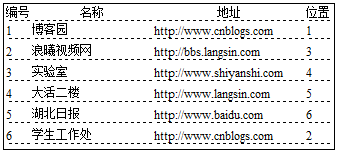XTemplate是Extjs里面的模板組件.
下面我們看個(gè)最簡單的例子.

  Ext.onReady(function() Ext.onReady(function() { {
 //數(shù)據(jù)源 //數(shù)據(jù)源
  var data= var data= { {
 name:"博客園", name:"博客園",
  read:[ read:[ { {
 book:'<<道不遠(yuǎn)人>>', book:'<<道不遠(yuǎn)人>>',
 date:'2007-7-7' date:'2007-7-7'
  }, }, { {
 book:"<<大話設(shè)計(jì)模式>>", book:"<<大話設(shè)計(jì)模式>>",
 date:"2006-6-6" date:"2006-6-6"
 }] }]
 } }
 //呈現(xiàn)組件 //呈現(xiàn)組件
  var mypanel=new Ext.Panel( var mypanel=new Ext.Panel( { {
 width:400, width:400,
 id:"mypanel", id:"mypanel",
 title:"XtemplateData簡單示例", title:"XtemplateData簡單示例",
 renderTo:Ext.getBody() renderTo:Ext.getBody()
 }); });
 //創(chuàng)建模板 //創(chuàng)建模板
 var tpl=new Ext.XTemplate( var tpl=new Ext.XTemplate(
  '<table><tr><th>名稱: '<table><tr><th>名稱: {name}</th></tr>', {name}</th></tr>',
 '<tr><td>', '<tr><td>',
 '<tpl for="read">', '<tpl for="read">',
  '<p>編號(hào): '<p>編號(hào): {#},書: {#},書: {book},日期: {book},日期: {date}</p>', {date}</p>',
 '</tpl></td></tr></table>' '</tpl></td></tr></table>'
 ); );
 //重寫綁定模板 //重寫綁定模板
 tpl.overwrite(mypanel.body,data); tpl.overwrite(mypanel.body,data);
 }) })
簡要說明:
  /**//* /**//*
 var tpl=new Ext.XTemplate( var tpl=new Ext.XTemplate(
 '<table><tr><th>名稱:{name}</th></tr>', '<table><tr><th>名稱:{name}</th></tr>',
 '<tr><td>', '<tr><td>',
 '<tpl for="read">', '<tpl for="read">',
 '<p>編號(hào):{#},書:{book},日期:{date}</p>', '<p>編號(hào):{#},書:{book},日期:{date}</p>',
 '</tpl></td></tr></table>' '</tpl></td></tr></table>'
 ); );
 tpl.compile(); tpl.compile();
 tpl.overwrite(mypanel.body,data); tpl.overwrite(mypanel.body,data);
 */ */
 1.tpl.compile();//可以在創(chuàng)建模板后,添加tpl.compile();編譯代碼,速度快點(diǎn). 1.tpl.compile();//可以在創(chuàng)建模板后,添加tpl.compile();編譯代碼,速度快點(diǎn).
 2. tpl.overwrite(mypanel.body,data);//把數(shù)據(jù)填充到模板中去,并呈現(xiàn)到目標(biāo)組件 2. tpl.overwrite(mypanel.body,data);//把數(shù)據(jù)填充到模板中去,并呈現(xiàn)到目標(biāo)組件
  3.名稱: 3.名稱: {name}//對(duì)于一維單數(shù)據(jù)對(duì)象,直接用{名稱}輸出, {name}//對(duì)于一維單數(shù)據(jù)對(duì)象,直接用{名稱}輸出,
 4.,<tpl for="read">//對(duì)于多維對(duì)象(如擁有多條數(shù)據(jù)的表),使用tpl和for配合使用,會(huì)使用tpl的格式把數(shù)據(jù)一條一條輸出,read為上級(jí)節(jié)點(diǎn) 4.,<tpl for="read">//對(duì)于多維對(duì)象(如擁有多條數(shù)據(jù)的表),使用tpl和for配合使用,會(huì)使用tpl的格式把數(shù)據(jù)一條一條輸出,read為上級(jí)節(jié)點(diǎn)
  5. 5. {.}//對(duì)于一維對(duì)數(shù)據(jù)的對(duì)象,如color: ['Red', 'Blue', 'Black'],可以用{.}按照tpl模板逐一輸出,如: {.}//對(duì)于一維對(duì)數(shù)據(jù)的對(duì)象,如color: ['Red', 'Blue', 'Black'],可以用{.}按照tpl模板逐一輸出,如:
 '<tpl for="color">', '<tpl for="color">',
  '<div> '<div>  {.}</div>', {.}</div>',
 '</tpl>' '</tpl>'
  6. 6. {#}//表示循環(huán)的索引 {#}//表示循環(huán)的索引
 7.parent.***//在子對(duì)象中訪問父對(duì)象元素,使用parent,如:{parent.name} 7.parent.***//在子對(duì)象中訪問父對(duì)象元素,使用parent,如:{parent.name}
 8.if//'<tpl if="age > 1">', 8.if//'<tpl if="age > 1">',
  '<p> '<p> {name}</p>', {name}</p>',
 '</tpl>', '</tpl>',
 //if實(shí)現(xiàn)有條件的邏輯判斷,很容易使用 //if實(shí)現(xiàn)有條件的邏輯判斷,很容易使用
 9.其他幾個(gè)常用的參數(shù): 9.其他幾個(gè)常用的參數(shù):
 xindex//循環(huán)模板的當(dāng)前索引index(從1開始),用[]。 xindex//循環(huán)模板的當(dāng)前索引index(從1開始),用[]。
 xcount//循環(huán)模板循環(huán)的次數(shù)。 用[] xcount//循環(huán)模板循環(huán)的次數(shù)。 用[]
 舉例: 舉例:
 '<tpl for="read">', '<tpl for="read">',
  '<p>編號(hào): '<p>編號(hào): {#},書: {#},書: {book},日期: {book},日期: {date},奇偶: {date},奇偶: {[xindex%2==0?"偶數(shù)":"奇數(shù)"]},次數(shù): {[xindex%2==0?"偶數(shù)":"奇數(shù)"]},次數(shù): {[xcount]}</p>', {[xcount]}</p>',
 '</tpl> '</tpl>
 10.模板成員函數(shù)(借用api下): 10.模板成員函數(shù)(借用api下):
 var tpl = new Ext.XTemplate( var tpl = new Ext.XTemplate(
 '<tpl for="kids">', '<tpl for="kids">',
 '<tpl if="this.isGirl(name)">', '<tpl if="this.isGirl(name)">',
  '<p>Girl: '<p>Girl:  {name} - {name} -  {age}</p>', {age}</p>',
 '</tpl>', '</tpl>',
 '<tpl if="this.isGirl(name) == false">', '<tpl if="this.isGirl(name) == false">',
  '<p>Boy: '<p>Boy:  {name} - {name} -  {age}</p>', {age}</p>',
 '</tpl>', '</tpl>',
  '</tpl></p>', '</tpl></p>',  { {
  isGirl: function(name) isGirl: function(name) { {
 return name == 'Sara Grace'; return name == 'Sara Grace';
 }, },
  isBaby: function(age) isBaby: function(age) { {
 return age < 1; return age < 1;
 } }
 }); });
接下來,我們做個(gè)服務(wù)器的例子(好像很多朋友對(duì)這個(gè)要求很強(qiáng)烈啊)
實(shí)例演示:用模板呈現(xiàn)服務(wù)器數(shù)據(jù)

 <div id="container"> <div id="container">
 </div> </div>  Ext.onReady(function() Ext.onReady(function() { {

 var mydata; var mydata;
  Ext.Ajax.request( Ext.Ajax.request( { {
 url:"getXtemplateData.ashx",//服務(wù)器端地址 url:"getXtemplateData.ashx",//服務(wù)器端地址
  success:function(request) success:function(request) { {
 mydata=request.responseText;//服務(wù)器端文本數(shù)據(jù) mydata=request.responseText;//服務(wù)器端文本數(shù)據(jù)
 mydata=eval('('+mydata+')');//使用eval把文本數(shù)據(jù)轉(zhuǎn)換為json對(duì)象 mydata=eval('('+mydata+')');//使用eval把文本數(shù)據(jù)轉(zhuǎn)換為json對(duì)象
 //或者用extjs自帶的方法:mydata=Ext.util.JSON.decode(mydata),效果相同 //或者用extjs自帶的方法:mydata=Ext.util.JSON.decode(mydata),效果相同
 var tpl2=new Ext.XTemplate( var tpl2=new Ext.XTemplate(
 '<table><thead><tr><th>編號(hào)</th><th class="namewidth">名稱</th><th class="urlwidth">地址</th><th>位置</th></tr></thead><tbody>', '<table><thead><tr><th>編號(hào)</th><th class="namewidth">名稱</th><th class="urlwidth">地址</th><th>位置</th></tr></thead><tbody>',
 '<tpl for="results">', '<tpl for="results">',
  '<tr><td> '<tr><td> {#}</td><td> {#}</td><td> {linkname}</td><td> {linkname}</td><td> {linkurl}</td><td> {linkurl}</td><td> {linkpos}</td><tr>', {linkpos}</td><tr>',
 '</tpl></tbody></table>' '</tpl></tbody></table>'
 ); );
 tpl2.compile(); tpl2.compile();
 tpl2.overwrite(Ext.get("container"),mydata); tpl2.overwrite(Ext.get("container"),mydata);

 }, },
 failure:function() failure:function()
   { {
 alert("failure!"); alert("failure!");
 } }
 }); });
 }) })

1.Ext.Ajax.request(),這里暫且對(duì)ajax不多談?wù)?后面會(huì)詳細(xì)敘述
2.eval用"()"可以把規(guī)范文本轉(zhuǎn)換為json對(duì)象,很重要!mydata=eval('('+mydata+')');
3.如果我們把模板創(chuàng)建和綁定放到ajax外面,會(huì)出錯(cuò),因?yàn)閍jax為異步調(diào)用,記住哦~
4.關(guān)于success函數(shù)的request參數(shù),我截個(gè)圖看看,就明白了
*/


|